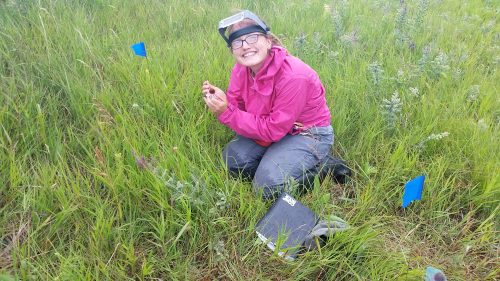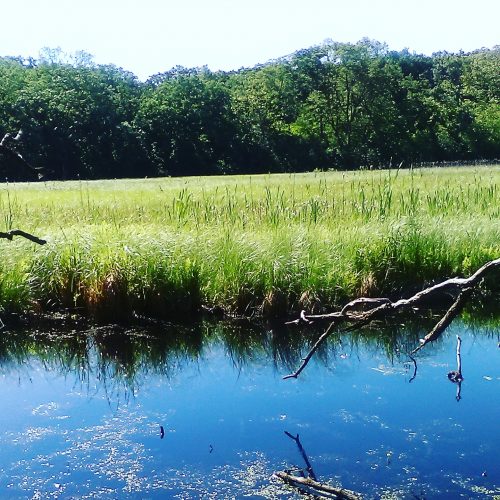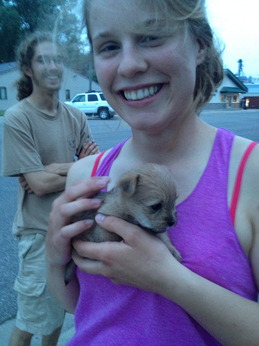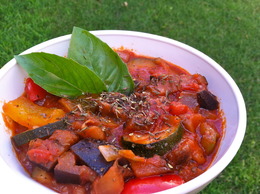|
|
Good afternoon, Flog readers!
As an REU intern and member of Team Echinacea, I get to do an independent research project of my choice. I’m excited to be studying the effect of style age, resource allocation, and pulse pollination on Echinacea angustifolia. I’ve attached my research proposal for your enjoyment and others’ future reference.
I’m excited to conduct this study!
My proposal: BARTO_Proposal_2017
 Bracts of rows 1, 3, and 5 painted.  Pollinating Echinacea
You may catch more flies with honey. And you also may catch more honeys being fly. But I catch more honeys (which aren’t actually “honeys” or honey bees but rather solitary bees) with a quiet step and lots of vials.
For my independent project, I am interested in examining the infraspecific pollen diversity load on different pollinators of Echinacea in this community. With a more diverse pollen load, the pollinators will likely be able to supply more compatible pollen to Echinacea plants.
During mid-flowering, I snuck up on many an un-suspecting pollinator in experimental plot p2 and caught them in vials. I then took these pollinators to experimental plot p1 and wiped them on receptive styles. After the heads are harvested, I will dissect the akenes and germinate the seeds. I will perform paternity testing on the first true leaf and be able to identify not only the distance traveled by the pollinator but also examine the diversity of the pollen donors for the seedlings.
Check out my full proposal:
Laura’s proposal: Intraspecific pollen diversity on pollinators of Echinacea angustifolia
I am excited to present to you my summer 2016 research proposal. While previous research has shown that isolated Echinacea plants and populations experience reduced reproductive fitness, we have not looked at what influence edge effects may have on Echinacea populations. Findings presented in Ison and Wagenius 2014 showed that plants in P1 experienced slight edge effects on seed set. My research this summer will use style persistence data collected from all remnant sites and quantify the relationship between distance of an Echinacea plant from a habitat edge and average style persistence. This will help us understand if fragmented populations are being harmed by yet another factor. Hopefully you find this topic as interesting as I do.
JamesEckhardtProposal2016
This summer, I will be examining the effects of removing buckthorn, a shrub that is invasive to Minnesota, on the edges of a bog near the Hjelm House. I am interested in seeing how removing buckthorn impacts the native plants, native invertebrates, soil quality, and exotic earthworm population. To learn more about my project, feel free to read my proposal! I’ve already been working on my project quite a bit and I can’t wait to get the final data and results!
Alyson’s Awesome Proposal – Click here to read the most exciting proposal you’ve ever read, probably.
 Here’s a sneak peak of the bog that I will be studying this summer! Isn’t it pretty?!
Here is a proposal for a fun project. It involves using demography data from this (and prior) years to estimate the growth rates of each of the remnants individually. Actually, that’s basically the whole project. Action items for the next month include: reading technical manuals with specifics on implementing aster models (see the list of project publications if you want to read them for me on your own).
scott_proposal_1
In other Scott-research related news, I will also try modeling fitness of various Hesperostipa spartea crosses in experimental plot 1. Just today I got a list of positions of plants found alive in 2016 — my plan in the near future is to search positions in the plot where plants were found alive in 2011 but weren’t found in 2016 to assess mortality. Keep your eyes open for another action-packed research proposal for this porcupine grass-ey project.
The small town of Kensington received five new adorable puppies last week. After some sleuthing and chatting with the friendly locals, team Echinacea received the chance for some much needed puppy playtime.

But what’s more exciting than puppies? Proposals and updated procedures!
Pollinator Efficiency Proposal 2014 .doc
Pollinator Efficiency Procedure.doc
PolObDatasheet_2014.xls
Attached to this post you will find team pollinator’s original proposal as well as an updated procedure and an updated datasheet. The past three weeks have flown by and we have already conducted observations on 175 heads! This means that we are only 25 heads short of our goal just in time for the end of flowering. It is also amazing how much we have learned and how much we have had to change our procedure. I hope that someone will pick up this project next summer and this updated information will help them to avoid some of the problems we’ve encountered.
In other exciting news, tonight I cooked Ratatouille for the team. Thank you Gretel and the Wagenius garden for the delicious basil!

My favorite French dish + my favorite people = the perfect end to a relaxing Sunday.
Here is the latest draft of my proposal to investigate the survival rates of Aphis echinaceae on Echinacea hybrids and the impact they have on host fitness:
CMS_proposal_8Jul2014.pdf
I’m excited to get started. In addition to my main project, I will be conducting and coordinating a variety of side projects related to aphids and Echinacea hybrids:
1. Katherine Muller and Lydia English’s aphid addition/exclusion experiment in P1.
2. Assessing fitness of the two Echinacea species and their hybrids in P6 (Josh’s Garden) and P7 (at Hegg Lake).
3. Recording flowering phenology of Echinacea pallida at Hegg Lake, where they were planted in a prairie restoration.
Team Echinacea has been hard at work in the field the last couple of weeks! But behind the scenes, we have also been working hard on designing our research projects for the summer. I am interested in looking at the asynchronous patterns of flowering phenology in E. angustifolia, and would also like to describe the co-flowering community. If you would like to know more, check out my draft of my project proposal!
|
|





